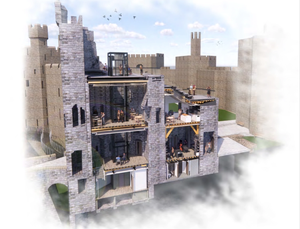 A report on a landmark project to redevelop the King’s Gate at Caernarfon Castle, published by CIAT, has been posted on Designing Buildings.
A report on a landmark project to redevelop the King’s Gate at Caernarfon Castle, published by CIAT, has been posted on Designing Buildings.
image: CIAT in DB
… important to maintain the charm and historic significance of the castle whilst also providing usable spaces and incorporating interventions…
DB hosts an article from CIAT:
… Since 2016, Buttress has been working with Cadw on a landmark project to redevelop the King’s Gate at Caernarfon Castle. Recognised internationally as one of the greatest structures of the Middle Ages, the castle is Grade I listed and a designated Scheduled Monument, becoming a part of Wales’ first UNESCO World Heritage Site in 1986. Our brief was to make a larger section of the upper battlements accessible to all, to improve interpretation of the site, and to create new visitor facilities including a caf provision and lookout, offering some of the best views across North Wales.
It was important to maintain the charm and historic significance of the castle whilst also providing usable spaces and incorporating interventions that are both reversible and non-intrusive. Our plans have added a new layer of architecture to the medieval building through the creation of a lightweight structure that sits on top of and within the triple-towered King’s Gate. On the upper levels, this structure spans the King’s Gate, providing seating areas offering views across the castle complex and beyond.
Given the castle’s designation as a World Heritage site and Scheduled Monument, the opportunity to introduce intrusive elements within accessible areas was restricted, whilst the archaeological constraints of the site limited the scope for any underground solutions. However, air source heat pumps have successfully been installed following careful consideration with Cadw. In addition, a layer of insulation has been introduced across each of the new tower roof decks as well as the installation of LEDs, linked to PIRs where practical. Materials and products have been sourced locally where available, such as stone from nearby quarries. The result is a bold and innovative approach, yet subtle from the exterior, challenging convention whilst revealing and enhancing universal value of this remarkable place. The castle is now accessible to a wider audience for future generations to enjoy and explore.
This article appears in the AT Journal Winter issue 144 under the same title and was wrtten by Alex Scrimshaw MCIAT, CIAT-Accredited Conservationist, Senior Architectural Technologist, Buttress.
